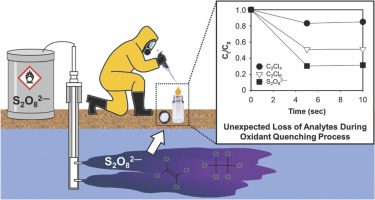Publication
Advanced Redox Technology Lab
Publication
Advanced Redox Technology Lab
Journal papers
To assess the performance of hazardous waste sites remediation technologies like in situ chemical oxidation (ISCO) with persulfate (S2O82−) researchers must periodically measure concentrations of target contaminants. Due to the presence of relatively high concentrations of the residual oxidant expected in many samples, the standard analytical method requires the addition of a relatively high concentration of ascorbic acid to prevent the oxidation process from continuing after sample collection. We discovered that addition of ascorbic acid quencher results in a radical chain reaction that transforms two common halogenated solvents (i.e., tetrachloroethene and hexachloroethane). To avoid the artifact associated with the radical chain reaction, a small quantity of n-hexane can be added to aqueous samples to extract target compounds and protect them from the radical chain reaction initiated by addition of the quencher. We recommend the use of this alternative sample preservation method whenever high concentrations of residual S2O82− are expected to be present in water samples that are contaminated with halogenated solvents.
